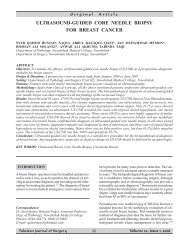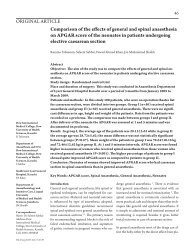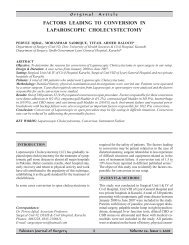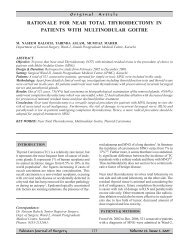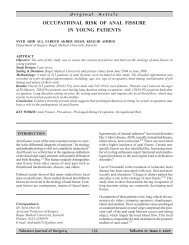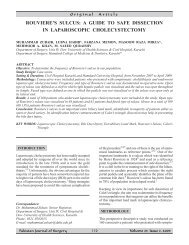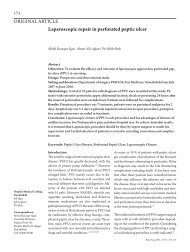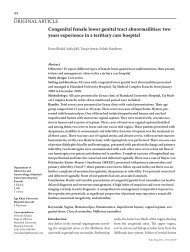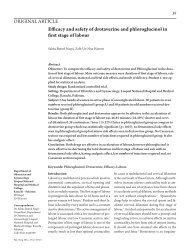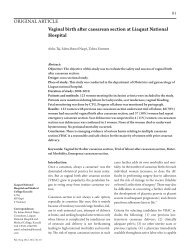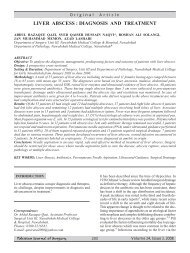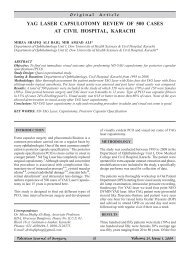13-Primary Vaginal.pdf - Pakistan Journal Of Surgery
13-Primary Vaginal.pdf - Pakistan Journal Of Surgery
13-Primary Vaginal.pdf - Pakistan Journal Of Surgery
Create successful ePaper yourself
Turn your PDF publications into a flip-book with our unique Google optimized e-Paper software.
Original<br />
Article<br />
RESULTS OF SURGICAL MANAGEMENT OF PRIMARY VAGINAL<br />
HYDROCELE IN PATIENTS OF ALL AGES IN ASH<br />
MUHAMMAD JAMALUDDIN, TANVEER ALAM, RIZWAN A. KHAN, S. M. ABBAS<br />
Department of <strong>Surgery</strong>, Abbasi Shaheed Hospital / KMDC, Karachi<br />
ABSTRACT<br />
Objective: To assess the results of surgical management of primary vaginal hydrocele in patients of all ages in Abbasi<br />
Shaheed Hospital.<br />
Study Design: Prospective and descriptive study.<br />
Setting & Duration: Surgical Unit I, Abbasi Shaheed Hospital and Karachi Medical and Dental College, Karachi<br />
from January 2003 to December 2005.<br />
Methodology: A total of 100 patients who were diagnosed as <strong>Primary</strong> <strong>Vaginal</strong> Hydrocele and surgically treated in<br />
the department of surgery of Abbasi Shaheed Hospital, during this period were included in this study. After clinical<br />
evaluation, investigations and inform consent, all patients (n=100) were divided into three groups according to the<br />
size of Hydrocele. Group A patients (n=20) having hydrocele size 10cm in diameter. Three<br />
surgical procedures were done in which Eversion of Sac is done in group A, Lord’s Procedure is done in group B<br />
and Jaboulay’s procedure was done in group C.<br />
Results: The data collected and results were analyzed on spss version 10. Post-operatively about 18% of patients<br />
developed mild hematoma and only 04% developed wound infection. No recurrence was found in any patients in a<br />
period of two years of follow up.<br />
Conclusion: These three surgical procedures were very safe, easy to perform and economical without any recurrence.<br />
KEY WORDS: <strong>Primary</strong> <strong>Vaginal</strong> Hydrocele, Lord’s Procedure, Jaboulay’s Procedure, Eversion of Sac<br />
INTRODUCTION<br />
<strong>Pakistan</strong> is an Islamic country, most of the people having<br />
religious thoughts and even males are shy, having any<br />
problem in genital or scrotal area hesitate to go to a<br />
doctor until their problem worsen or get complicated. 1,2<br />
The main reasons for refusing in the past were the high<br />
cost of surgery, and to some extent fear of death and<br />
impotence and or sterility that might result from surgery. 3<br />
Patients having hydrocele faces the same situation. 4<br />
They do not want to be examined initially but when<br />
these patients were explained the importance of exami-<br />
Correspondence:<br />
Dr. Muhammad Jamaluddin, Dept. of <strong>Surgery</strong>,<br />
Abbasi Shaheed Hospital, Karachi.<br />
Phones: 0300-2167612.<br />
E-mail: drmjdin@hotmail.com<br />
nation and advantage of surgical treatment 5 , most of<br />
them agreed but some of them refused and did not return<br />
for surgery.<br />
This study will be beneficial for our colleag-ues and<br />
for all patients of hydrocele, so that they can be educated<br />
to adopt easy, safe and best surgical procedures for the<br />
primary vaginal hydrocele. 6 Hydrocele is the most<br />
common scrotal swelling and usually associated with<br />
hot climate. It usually involves middle and old ages but<br />
may occur in young and childhood. As it is painless 7 ,<br />
so patients bear it for a long periods until it gets complicated<br />
or attain huge size 8,9 , and a few are associated<br />
with inguinal hernias. 10<br />
Diagnosis is usually clinical 11 but ultrasound of scrotum<br />
is also diagnostic. 12-15 There were many non operative<br />
16-22 and operative treatment 23,24 but the three surgical<br />
procedures were commonly employed. i.e. Eversion of<br />
sac, Lord’s procedure 25,26 and Jaboulay’s procedure 27<br />
to treat primary vaginal hydrocele. 28<br />
190<br />
Volume 25, Issue 3, 2009
Results of surgical management of primary vaginal hydrocele<br />
M. Jamaluddin, et al<br />
METHODOLOGY<br />
This study was conducted at Surgical Unit I, Abbasi<br />
Shaheed Hospital, Karachi from January 2003 to<br />
December 2005 on 100 patients who were diagnosed<br />
as <strong>Primary</strong> <strong>Vaginal</strong> Hydrocele. These patients were first<br />
seen in surgical OPDs of ASH during this period with<br />
no other associated disease or complication. All patients<br />
having infantile hydrocele, congenital hydrocele, secondary<br />
hydrocele or primary hydrocele with complications<br />
were excluded from this study. In OPD a detail history,<br />
clinical examination and investigations (CBC, ESR,<br />
Sugar, Urea, Urine DR, X-ray chest) including ultrasound<br />
of scrotum done to confirm the diagnosis and to exclude<br />
other causes of scrotal swellings and secondary hydrocele.<br />
Informed consent was taken from all patients and<br />
proforma was filled. Patients were admitted one day<br />
before surgery according to protocol of ASH.<br />
OPERATIVE TECHNIQUE<br />
All procedures were done in operation theatre under<br />
general and spinal anesthesia according to the condition<br />
of the patients. Three doses of antibiotics i.e. first generation<br />
cephalosporin were given iv as prophylaxis in<br />
which first dose was given just before induction of<br />
anesthesia, 2nd dose after 6 hours and 3rd dose after<br />
12 hours of operation. Povidone iodine and spirit were<br />
used for sterilization. After anesthesia, scrubbing and<br />
toweling incision were given in the scrotum and hydrocele<br />
sac exposed and measured by an inch tape. Then<br />
the sac was opened and hydrocele fluid drained was<br />
measured. Simple Eversion of sac was done in children<br />
and patients less than 20 years of age with hydrocele<br />
sac less than 5cm in diameter (20 patiens). Lord’s procedure<br />
was done in ages between 20-50 years with hydrocele<br />
sac of 05-10 cms in diameter (50 patiens). Jaboulay’s<br />
procedure was done in patients above 30 years with<br />
hydrocele sac more than 10cm in diameter (30 patiens).<br />
A drain tube and suspensory bandage was used in<br />
medium and large sized hydroceles postoperatively<br />
(Table I).<br />
All patients who have no complication were discharged<br />
after 48 hours of surgery and were advised to attend<br />
Table I. Procedures Employed<br />
Surgical Procedures<br />
Eversion of sac<br />
Lord’s procedure<br />
Jaboulay’s procedure<br />
Total<br />
No.<br />
20<br />
50<br />
30<br />
100<br />
%.<br />
20<br />
30<br />
50<br />
100<br />
Ages<br />
10 Years<br />
10-20 Years<br />
Total<br />
Lord’s Procedure<br />
20-30 Years<br />
30-40 Years<br />
40-50 Years<br />
Total<br />
Jaboulay’s Procedure<br />
30-40 Years<br />
40-50 Years<br />
> 50 Years<br />
Total<br />
No. of Patients<br />
<strong>13</strong><br />
7<br />
20<br />
<strong>13</strong><br />
14<br />
23<br />
50<br />
<strong>13</strong><br />
15<br />
12<br />
30<br />
Table II. Ages of patients used for procedures<br />
SOPD for follow-up for at least six months according<br />
to the protocol given in the chart with special reference<br />
to hematoma, infection and recurrence.<br />
During each follow up patients were looked for agonizing<br />
pain, fever, wound infection, hematoma and recurrence.<br />
Patients having no complication after discharge were<br />
allowed to join their work after 48 hours. Patients having<br />
hematoma were discharged after 5-7 days and those<br />
having wound infection were discharged after 10th day<br />
of surgery (Table II).<br />
RESULTS<br />
Clinical findings: Scrotal swelling and get above the<br />
Table III. Amount of Fluid Drained<br />
Fluid Drained (ml)<br />
< 25<br />
26-50<br />
51-100<br />
101-200<br />
201-300<br />
301-400<br />
401-500<br />
Total<br />
No.<br />
8<br />
32<br />
28<br />
14<br />
7<br />
9<br />
2<br />
100<br />
%.<br />
8<br />
32<br />
28<br />
14<br />
7<br />
9<br />
2<br />
100<br />
191<br />
Volume 25, Issue 3, 2009
Results of surgical management of primary vaginal hydrocele<br />
M. Jamaluddin, et al<br />
Procedure No. of Patients Pain Haematoma Wound Infection<br />
Eversion of sac<br />
Lord’s procedure<br />
Jaboulay’s procedure<br />
Total<br />
20<br />
50<br />
30<br />
100<br />
4<br />
11<br />
7<br />
22<br />
4<br />
6<br />
8<br />
18<br />
Nil<br />
1<br />
3<br />
4<br />
Table IV. Post-operative complications within one week<br />
Complication 2 Weeks 4 Weeks 8 Weeks<br />
24 Weeks<br />
Pain<br />
Haematoma<br />
Wound Infection<br />
Recurrence<br />
22 Patients<br />
18 Patients<br />
04 Patients<br />
None<br />
None<br />
04 Patients<br />
None<br />
None<br />
None<br />
None<br />
None<br />
None<br />
None<br />
None<br />
None<br />
None<br />
swelling was present in all cases, transillumination test<br />
was present in all cases, cough impulse was absent and<br />
testes were not palpable separately in any case. About<br />
<strong>13</strong> cases of secondary hydrocele was found and three<br />
cases of testicular tumor was also found but excluded<br />
from this study (Table III).<br />
Out of 100 patients only 22 patients had mild to moderate<br />
pain within two to three weeks of surgery which settled<br />
by giving simple analgesics like diclofenac sodium<br />
along with scrotal support (Table IV-VI).<br />
DISCUSSION<br />
In this study the main clinical features, diagnostic<br />
modalities and different surgical treatment were studied.<br />
According to a study the age incidence of the patients<br />
of primary vaginal hydrocele is usually middle or old<br />
age but in our study it is found that most of the patients<br />
were below forty years of age i.e. <strong>Primary</strong> vaginal<br />
hydrocele is frequently found in children and young<br />
pts and less frequently after 50 years. 29 The presenting<br />
features were painless scrotal swelling but in some<br />
Table VI. Final Results<br />
Total No. of Patients<br />
Haematoma<br />
Wound Infection<br />
Recurrence<br />
Success Rate<br />
No.<br />
18<br />
4<br />
--<br />
Table V. Follow-up Results<br />
%.<br />
18<br />
4<br />
--<br />
78<br />
patients some discomfort is also noted. 30 In large and<br />
tense hydroceles testes was not felt separately as<br />
compared to a study in which it is present in about 5%<br />
of cases. There was no association with inguinal hernias<br />
as some authors showed 5% is associated with inguinal<br />
hernias. Most of the patients contain large amount of<br />
fluid in the hydroceles sac and fluid is mainly clear<br />
amber colored and sterile on culture. 31<br />
Post-operative complications after these surgical procedures<br />
were very minimal with few (18%) hematoma<br />
and (04%) wound infection is noted. No recurrence<br />
was found as compared to other methods of treatment. 32<br />
Recoveries of the patients were excellent and hospital<br />
stay was also very minimal in almost all cases except<br />
04% of cases of infection. 3 Patients returned home early<br />
and joined their daily routine after a few days of surgery. 3<br />
Different workers tried different treatment to minimize<br />
the post-op complication 33,34 and to reduce chances of<br />
hematoma formation but after this study it is obvious<br />
that the classic technique for primary vaginal hydroceles<br />
are simple Eversion of sac alone or Eversion of sac<br />
which plicate to form a bunch as in Lord’s procedure 35<br />
or Eversion of sac with removal of some part of it and<br />
suturing the remaining part around the testes as in<br />
Jaboulay’s procedure. The success rate after these<br />
procedures was found to be higher as compared to the<br />
other study 36 like aspiration or sclerotherapy 37,38 where<br />
infection 39 and recurrence are common. 40<br />
CONCLUSION<br />
These three surgical procedures (Eversion of sac, Lord’s<br />
192<br />
Volume 25, Issue 3, 2009
Results of surgical management of primary vaginal hydrocele<br />
M. Jamaluddin, et al<br />
procedure and Jaboulay’s procedure) are economical,<br />
safe and least time consuming and without any<br />
recurrence.<br />
REFERENCES<br />
1. Pinna C C, Rodraguez Rinca J P, Mirat J. Spontaneous<br />
rupture of hydrocele: an unusual complication.<br />
Actas Urol Esp 1998; 22(7): 610-12.<br />
2. Rados N, Trnski D, Keros P, Rados J. The biochemical<br />
aspect of testis hydrocele. Acta Med Croatica<br />
1996; 50(1): 33-36.<br />
3. Ahorlu C K, Dunyo S K, Asamoah G, Simonsen P<br />
E. Consequences of hydrocele and the benefits of<br />
hydrocelectomy: a qualitative study in lymphatic<br />
filariasis endemic communities on the coast of<br />
Ghana. Acta Trop 2001; 80(3): 215-21.<br />
4. Gyapong M, Gyapong J, Weiss M, Tanner M. The<br />
burden of hydrocele on men in Northern Ghana.<br />
Acta Trop 2000; 77(3): 287-94.<br />
5. Marchal Escalona C, Chicharro Molero J A. Local<br />
anaesthesia in the surgical management of hydrocele<br />
and cysts of the spermatic cord. Actas Urol Esp<br />
1993; 17(1): 68-72.<br />
6. Apko E E. Giant hydrocele- an epitome of neglect.<br />
Afr Health Sci 2005; 5(4): 343-4.<br />
7. Jahnson S, Johansson J E. Results of window operation<br />
for primary hydrocele. Urology 1993; 41(1):<br />
27-28.<br />
8. Cheng L. A case control study of dangerous factors<br />
related to infertility. Chng-Hua-Liu-Hsing-Ping-<br />
Hsueh-Tsa-Chih 1991; 12(4): 217-21.<br />
9. Murillo Mirat J, Moran Penco J M, Cabello Padial<br />
J. Abdomino-scrotal hydrocele, an unusual disease,<br />
revew of the literature, and report of a new case.<br />
Actas Urol Esp 1994; 18(8): 838-40.<br />
10. Skoog S J, Colin M J. Pedriatric hernias and hydroceles.<br />
The urologist’s perspective. Urol Clin North<br />
Am 1995; 22(1): 119-30.<br />
11. Zornow D H, Landes R R. Scrotal palpation. Am<br />
Fam Physician 1981; 23(1): 150-54.<br />
12. Espuela Orgaz R, Nogueras Gimeno M A, Saiz<br />
Santana P. Diagnostic importance of ultrasonics in<br />
intrascrotal pathology. Actas Urol Esp 1983; 7(5):<br />
361-68.<br />
<strong>13</strong>. Benjamin K. Scrotal and inguinal masses in the<br />
newborn period. Adv Neonatal Care 2002; 2(3):<br />
140-48.<br />
14. Macksood M J, James R E. The srotal mass: cause<br />
and diagnosis. Am Journ Surg 1983; 145(2): 297-<br />
99.<br />
15. Rifkin M D. Scrotal ultrasound. Urol-Radiol 1987;<br />
9(2): 119-26.<br />
16. Fariata L A, Villavicencio H. Treatment of hydrocele<br />
with evacuation and percutaneous sclerosis with<br />
polidocanol. Actas Urol Esp 1994; 18(6): 690-93.<br />
17. Lapez Laur J D, Parisi J. Sclerotherapy of hydroceles<br />
with oxytetracyclines. Actas Urol Esp 1989; <strong>13</strong>(6):<br />
439-40.<br />
18. Abdel Raheem M S. Cause of primary vaginal<br />
hydrocele and ascites in advanced liver cirrhosis.<br />
Am Journ Surg 1983; 146(5): 647-51.<br />
19. Dimberg M, Norlen H, Zachrisson L, Lindholm H.<br />
Testicular hydrocele treated by bismuth phosphate<br />
injection. Int Urol Nephrol 1988; 20(2): 155-7.<br />
20. Ozkan S, Birkan K, Ozen H. Treatment of testicular<br />
hydrocele with tetracycline sclerotherapy. Int Urol<br />
Nephrol 1990; 22(1): 67-9.<br />
21. Yamamoto M, Hibi H, Miyake K. A new sclerosant<br />
therapy for testicular hydrocele with aspiration and<br />
injection of OK-432. Int Urol Nephrol 1994; 26(2):<br />
205-8.<br />
22. Fuse H, Sakamoto M, Fujishiro Y, Katayama T.<br />
Sclerotherapy of hydrocele with polidocanol. Int<br />
Urol Nephrol 1994; 26(2): 199-204.<br />
23. Cecchi M, Sepich C A, Pagni G. Painless treatment<br />
of Hydrocele: Int Urol Nephrol 1997; 29(4): 457-<br />
59.<br />
24. Miroglu C, Tokuc R, Saporta L. Comparison of an<br />
extrusion procedure and eversion procedures in the<br />
treatment of hydrocele. Int Urol Nephrol 1994;<br />
26(6): 673-79.<br />
25. Farquharson’s text book of operative surgery, 7th<br />
edition.<br />
26. Albrecht W, Holtl W, Aharinejad S, Br J Urol 1991.<br />
193<br />
Volume 25, Issue 3, 2009
Results of surgical management of primary vaginal hydrocele<br />
M. Jamaluddin, et al<br />
27. A Pract Guide to operative Surg: S. Das, 3rd Edition.<br />
28. Kristiansen V B, Kjems E, Sarensen C, Sandergaard<br />
J O. Hydrocele in children: indication for operation<br />
and surgical technique. Acta Chir Belg; 1989; 89(4):<br />
221-3.<br />
29. Arsalan A S, Incesu L, Yalin T, EL M, Belet U.<br />
Bilateral abdominoscrotal hydrocele. Abdom<br />
Imaging 1996; 21(2): 177-8.<br />
30. Hajgaard Rasmussen H, SchrA der P. Testicular<br />
hydrocele: an initial sign of colon carcinoma. Case<br />
report. Acta Chir Scand 1988; 154(1): 65-66.<br />
31. Gooding G A, Leonhardt W C, Marshall G, Seltzer<br />
M A, Presti J C. Cholesterol crystals in hydroceles:<br />
sonographic detection and possible significance.<br />
AJR Am J Roentgenol 1997; 169(2): 527-79.<br />
32. Honnens de Lichtenberg M, Miskowiak J, Krogh<br />
J. Tetracycline sclerotherapy of hydroceles and<br />
epididymal cysts. Long term results. Acta Chir<br />
Scand. 1990; 156(6-7): 439-40.<br />
33. Miroglu C, Tokuc R, Saporta L. Comparison of an<br />
extrusion procedure and eversion procedure in the<br />
treatment of hydrocele. Int Urol Nephrol 1994;<br />
26(6): 673-79.<br />
34. Ceylan K, HasanG, Alpaslan K. Inguinal approach<br />
in adult hydrocele surgery: preliminary randomized<br />
study. Adv Ther 2006; 23(1): 159-62.<br />
35. Singh D R, Gupta S K, Gupta S. Lord’s procedure:<br />
a curative outpatient operation for primary hydrocele.<br />
Journ Ind Med Assoc 1996; 94(4): 141-42.<br />
36. Nishiyama T, Terunuma M. Endoscopic hydrocele<br />
fulguration. Hinyokika-Kiyo 1994; 40(2): 125-6.<br />
37. Merenciano Cortina F J, Rafie Mazketli W, Amat<br />
Cecilia M. Sclerotherapy of hydrocele and cord<br />
cyst with polidocanol. Efficiency study. Actas Urol<br />
Esp 2001; 25(10): 704-9.<br />
38. Hellstorm P, Malinen L, Kontturi M. Sclerotherapy<br />
for hydroceles and epididymal cysts with ethanolamine<br />
oleate. Ann Chir Gynae 1986; 75(1): 51-54.<br />
39. Audry G, Johanet S, Achrafi H, Lupold M, Gruner<br />
M. The risk of wound infection after inguinal<br />
incision in pediatric outpatient surgery. Eur Jour<br />
Pediatr Surg 1994; 4(2): 87-89.<br />
40. Saha P K, Kanda S, Morimitsu H, Nishimura N,<br />
Saito Y. Transforming growth factor beta-like<br />
activity in human hydrocele fluid. Urol Res 1990;<br />
18(4): 295-98.<br />
194<br />
Volume 25, Issue 3, 2009



